
Travel
Biking Around Provence
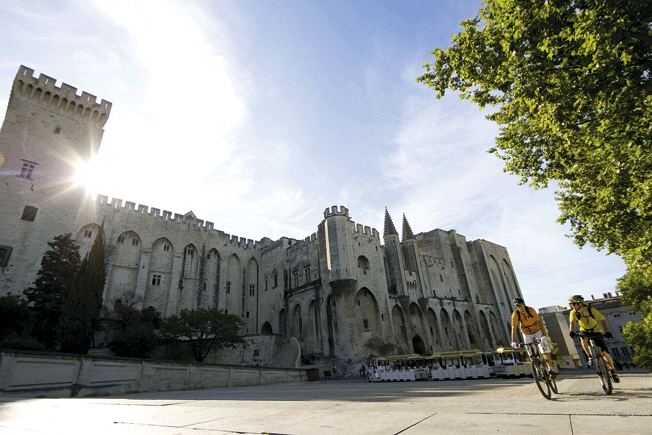
The plan was a simple one. In the middle of a weeklong trip to France last July,
a trip prompted
by an invitation to a friend’s wedding celebration,
we would swing down to
Provence for a sweet,
romantic, three-day bicycle trip.
By: Joe Nocera
I had been to Provence several times in my life, and I had exhilarating, if somewhat faded, memories of the region: the Roman ruins near Orange, the magnificent Palais des Papes inside the walls of Avignon, the olive groves and lavender and fields of sunflowers that clotted the Provencal countryside. She, however, had never been there. I would be her guide. I liked that idea.
I’d wanted to avoid the typical luxe bike tour, the sort of trip where a dozen or more strangers are led by a professional guide by day and then all pile into a five-star hotel for an over-the-top communal dinner by night. I was yearning for something smaller and more intimate – and, given the times we live in, less expensive. On the Internet, I had found Cyclomundo, a five-year-old company run by an amiable 44-year-old named Bruno Toutain, who had turned his passion for cycling into a business that offered something called “self-guided” cycling tours.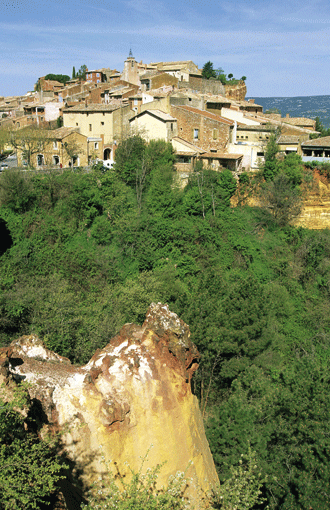
“I used to work as a guide on guided bike tours, and it wasn’t really satisfying,” Toutain told me when I called to get his story. “It was one notch above a bus tour company. The people are not part of the landscape. They weren’t enough of an actor in their own trip. There was too much guidance.”
His approach was a little more do-it-yourself. Instead of pedaling behind a guide, we would be given laminated maps that laid out each day’s route, along with highly detailed route instructions. (Typical direction: “At the crossing, there is a bakery. Follow the street right next to it +- 0.2 km.”) The bicycles we rented had stands attached to the handles, allowing the maps to be mounted like sheet music on a music stand. We could take as long as we wanted getting to our daily destination – nobody cared. For a fixed – and quite reasonable – price, Cyclomundo also booked either three- or four-star hotels for each night of our trip, with dinner included. And, of course, Cyclomundo would pick up our luggage at each stop and deposit it at the next hotel well before we arrived. All we had to do was get there ...whenever.
Though Cyclomundo offers bicycle trips in Spain, Italy and Switzerland, its trips through France are its bread and butter. Most of the trips last five or six days, on routes with varying degrees of difficulty: “We can give you something close to the Tour de France, if you wish,” Toutain boasted. Truth to tell, she could probably have handled that, but one loop around Central Park is usually enough for me, so I asked for something a little less taxing.
Toutain assured me that he had the perfect three-day trip for the likes of me: Avignon to St.-Remy-de-Provence the first day (15 miles); St.-Remy to Arles on Day 2 (29 miles); and Arles back to Avignon on the last day (35 miles). For most of the trip, we would be on small back roads, not pressured by traffic or time, able to take in the sights and smells at our own pace. “We do a lot of honeymoon trips,” Toutain said. That sounded about right.
Our friends’ wedding luncheon was in the Jura, a region in the eastern part of France, and we got a late start to Avignon. It was dark when we arrived. And here I confess, dear reader, my plan began to go awry. In my eagerness to show her old Avignon, the historic town inside ancient fortress walls, I had booked, via Orbitz, an inexpensive two-star hotel in that part of town. A bad mistake.
The cobbled, claustrophobic streets, so glorious when you’re on foot, were hideous in a car at night. Narrow, one-way, twisting and turning around ancient buildings and modern shops, there was no way I could make sense of them. The fortress walls blocked my GPS. Because the annual Avignon summer arts festival was in full force, we couldn’t find a place to park – or even to slow down to look at street signs or ask for help. “Do you know where you’re going?” she asked with a sigh. “I know it’s right around here somewhere,” I said.
In its confirmation e-mail message, the hotel had informed us that they locked the doors at 11 p.m. We had been driving the same handful of streets for more than an hour and it was nearly 10:45. Then she spotted the parking space. “Park there,” she commanded. She leapt out of the car and swung into action. Affecting a sweetness she most certainly did not feel, she explained our dilemma to a vendor who was standing across the street. He smiled, called the hotel, got the directions and pointed us on our way. We left the car right where it was, and got there with minutes to spare.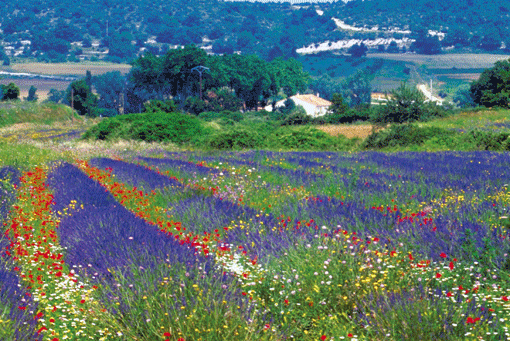
I wish I could say that was the worst of it, but it wasn’t. The hotel I had booked turned out to be something out of the Addams Family, dank and dirty, and our room – in the attic! – was a horror show. A ratty air-conditioning unit barely worked, and when we threw open the windows for some desperately needed air, we discovered that the windows opened up to the inside of the hotel. She went downstairs to demand an upgrade, but it was too late – there was nobody at the desk. After a fitful night of tossing and turning, we checked out at 6 a.m., practically gasping for air.
So much for showing her Avignon, we spent the next four hours waiting for the bike shop to open so we could rent our bikes and get out of town. I parked her in the lobby of a hotel – a modern one, thank goodness, outside the fortress walls – where she sipped coffee and freshened up in the bathroom. I, meanwhile, got hauled off to the police station for making an illegal U-turn. (Note to travelers: No matter how frustrated you are, don’t say “Oh, c’mon,” when the gendarmes pull you over.) “Where have you been?” she asked when I returned. Now even I couldn’t wait to get out of town.
The young man at the bike shop had our hybrid mountain bikes ready for us when we arrived a few minutes after 10. He handed us a little repair kit in case we had a flat, helmets and three days’ worth of maps and directions, which, I later discovered, had been drawn up by his boss, the bike shop’s owner. (Later, when I asked the owner to give me copies of the routes for this article, he resisted: “They are my business advantage,” he kept saying.) We handed him our luggage. In our flip-flops and shorts, we were on our way.
Fifteen miles on a bicycle – the distance to St.-Remy – is not a long trip, even for me. The point of the first day’s ride, it would seem, is to get yourself acclimated. It was confusing in the beginning. On the main road out of town, there were plenty of signs to St.-Remy, and it took me a while to realize that I had to ignore them. The point was to follow the map and the directions, which kept us off the main roads as much as possible.
At first, though, that had its own set of difficulties. The maps and directions were on different sheets of paper, but you could put only one of them on the stand. She was perfectly content to let me juggle both, but I found myself constantly stopping to look at one and then the other. When we stopped to sip water, I would try to memorize the next three or four steps. Eventually, though, I got comfortable with the directions on my stand, and began to pay more attention to the scenery than the route itself.
Touring by bike is different from touring by car – you see more, for sure, but in a deeply sensory way, you experience more. There was nothing on this route that was especially earth-shattering – and yet from the vantage point of our bikes, it all was. The perfectly rolled hay. The acres of sunflowers. The stone walls. The sweet farmhouses. We passed our first farm, and remarked to each other how happy Provencal cows looked up close, well-fed and well-tended. We stopped to inspect our first olive grove. We pedaled past a lavender field, and soaked in the sweet aroma. We biked through Graveson and Maillane, two small Provencal towns, taking pictures of churches and cemeteries, where we read the inscriptions and wondered about lives lived. She had brought some cheese, and as we passed a farm with pear trees, she jumped off her bike, and grabbed two pears. That was lunch. Within an hour on the bike, the travails of Avignon were forgotten. We were happy again.
Still, even taking our sweet time, we were almost in St.-Remy by noon. She had somehow learned that every Wednesday, there was a big open-air market in St.-Remy, and she wanted to see it. But then I saw a sign: “Les Baux,” it read, ‘’9 km.’’ And here, dear reader, I did it again.
Les Baux de Provence is another one of the great French tourist spots of my distant memory. High in the mountains, atop a beautiful medieval town and overlooking a steep cliff, sit the ruins of a once-great fortress – as well as other ancient, excavated ruins that go back as far as the first century. It is, to me, a magical place, and I remember taking my children there when they were young and watching their glee and awe as they climbed around the ruins.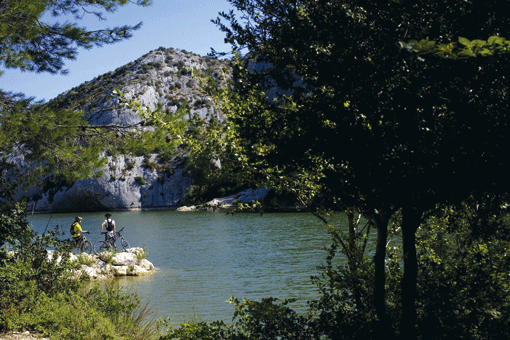
I looked at my watch. “Les Baux is great!” I said to her excitedly. “Let’s go there. We’ll still be in St.-Remy by 2 p.m.” She shot me a dubious glance, but off we went.
Did I mention that Les Baux was high in the mountains? There was a reason Toutain had not included it in the route he gave us. This was not a smell-the-lavender kind of ride; within a few minutes we were climbing straight up, and it was brutal. I finally had to get off my bike and start walking it up the hills. She gave me a disdainful glance as she pedaled on.
By the time we spotted Les Baux, the magnitude of my error was manifest to both of us. Having ridden to the top of the mountain, we could see the magnificent contours of the old fortress – on the next mountain over. To actually get there would require going down the other side of the mountain we had just climbed and up another one.
“So,” she said, “What do you want to do?” I took out my camera. “Let’s take a few pictures and go back,” I said. She gave me a look that said, “I’m glad you’ve come to your senses.” We sped down the mountain, and got to St.-Remy around 1 p.m._ only to discover that the open-air market was shutting down. Oy. Then on to the hotel. My assumption was that after we checked in and had lunch, we would head back out again to tour the city. Not a chance. Seeing our bags in the room, she rummaged through hers, and pulled out a bathing suit. “I’m not moving,” she said.
On the other hand, why would we move? As it turns out, Toutain was much better at choosing hotels in Provence than I was. Le Mas des Carassins, where we stayed that night, was an old farmhouse, slightly off the beaten track, that had been converted into a stylish, modern hotel. The two owners, Michel Dimeux and Pierre Ticot, were refugees from the corporate world who had bought the place in 2000 and spent three years renovating it. They put in the swimming pool, created a series of gorgeous gardens and hired a first-rate chef. It felt secluded, even though it wasn’t. We spent the rest of the afternoon sitting under an olive tree, reading, sipping a lovely local beverage. At night, after a lovely dinner of local veal, we could hear a wolf howling in the distance.
It was warm the next morning, but there was a crisp wind. After saying our goodbyes to Dimeux, we set off for Arles. Just out of town, with her riding a little ahead of me, a sudden gust of wind blew my directions off the stand. “Wait,” I yelled. But she didn’t hear me. I ran back to recover the directions; once I retrieved them, I realized she was nowhere to be seen. “She must have just gone ahead,” I thought. So I continued along the road.
And yes, dear reader, it happened again. In fact, she had seen a sign for Arles and set off, while my directions had taken me in the opposite direction. When I finally realized she wasn’t there, we were miles apart. We had made the conscious decision not to take our cell phones on this trip, but that also meant that now we had no way of getting in touch with each other. I rode down various roads looking for her. I waited at the point where I thought she must have turned off, thinking she would eventually return. I doubled back to St.-Remy. She wasn’t there. I finally decided to follow my directions to Arles and hoped she got there.
And sure enough, she did. When I arrived at our hotel in Arles, a pleasant enough place called Le Calendal, right in the center of town, she had been there for more than an hour. She was waiting anxiously for me. “I’ve been so worried,” she said. I’ve had worse reunions.
As it turns out, she had had her own adventure that day. She had waited for me at the place where she turned off the road – which was a different spot from the one where I had waited for her. For much of the time, we were probably no more than 200 yards apart. Eventually, a man had stopped to help, and had let her use his cell phone to call Cyclomundo. He had then driven her in his truck to the main road, which she took to get to the hotel.
“Let’s walk around,” I said after she told me her story. I had never been to Arles before, so instead of trying to be the guide, I discovered the great Roman amphitheater of Arles with her at my side. We sat in the stands, contemplating gladiators and bullfights (the latter still take place there). We poked our heads into art galleries and shops. We talked and laughed about the day we’d both had.
And we stumbled upon a restaurant that night called Le Cilantro, where we had a meal as memorable as any I can remember: caramelized frogs’ legs, stuffed saddle of lamb, lobster in a stunning emulsion. The young chef, Jerome Laurent, who had started the restaurant in 2004, was holding court with some customers, but during dessert (white and yellow peach in a citrus-flavored soup) he came over to talk to us. As we raved about the meal, he told us he had worked for Alain Ducasse, and had spent time in the United States, his last stop being the Meridien Hotel in Boston. But Arles was home. “I grew up here,” he said. “My parents live across the street.” Lucky Arles. Lucky us.
And then it was our last day of biking in Provence, and nothing went wrong, not even for a second. It was the longest day of biking, but we only wanted it to be longer. We stopped every few miles, to take pictures or soak in the scenery. She saw an olive farm selling olive oil, and we pulled in to buy some. The proprietor came outside with us, and took our pictures together.
A half hour later, we weren’t on any road at all – our directions had put us on a path so narrow that no car could ever get down it. On one side ran a canal, flowing with cold water. On the other side was a series of farms where horses grazed. We were stunned at the beauty we found ourselves in. “Can you believe this?” I kept asking. All she could do in response was giggle and take more photos. We were seeing something no tourist could see without a bicycle – that, and a map drawn by a man who viewed this path as his intellectual property. I knew right then that this would be my memory of this trip. Or rather, it would be our memory.
We finally arrived in Avignon late in the afternoon. There was still plenty of daylight left, and I suppose we could have wandered back into central Avignon, perhaps even visited the Palais des Papes. But I’d learned my lesson. I no longer wanted to show her my Provence; I now understood that the point of this trip was to discover our Provence. It was better that way. The bikes had given us a new way to experience a very old place.
In St.-Remy, Michel Dimeux had told us about a town called Gordes, where he and his partner had put in a second hotel. I had never been there before, and knew nothing about it. It was, he said (correctly, it turns out), a spectacular village built into the side of a mountain, which had been transformed into an artists’ colony and tourist haven.
We got in our car and headed off to Gordes, without so much as a glance backward.
Over the Handlebars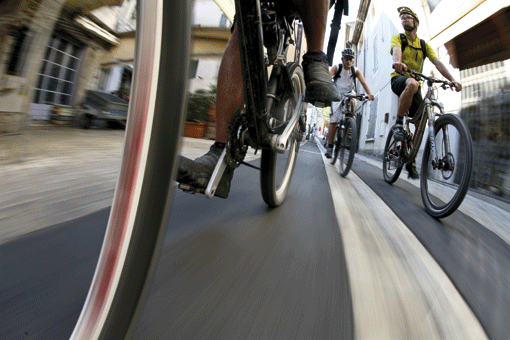
Getting There
To get to Avignon by plane from New York can mean connections and airfares of $1,400 or more for travel this summer, based on a recent Web search. A better option is to fly to either Paris or Marseille and then take a train to Avignon. From Paris, direct TGV trains from Gare de Lyon take about two and a half hours, and one-way fares start at around $78 for a restricted second-class ticket and at around $252 for a refundable first-class ticket. Trains depart frequently from Marseille, with some journeys taking as little as 30 minutes and one-way fares starting at $25. For train information and reservations, go to www.raileurope.com or call (800) 622-8600.
Biking around Provence
Cyclomundo (33-4-5087-2109 or 212-504-8368; www.cyclomundo.com,) offers guided or self-guided bike tours in France, Spain, Italy and Switzerland. Self-guided tours usually include daily lodging with breakfast, some or all lunches and dinners (as stated in the tour description), luggage transfers, maps and itinerary. According to the company’s Web site, accommodation options range from “four-star hotels on deluxe tours to ‘bivouac’ on some mountain-bike tours, and everything in between.” There are almost a dozen self-guided options offered in Provence, ranging from the three-day, two-night “Short Escape: from Avignon to Arles” journey, with prices starting at 275 euros (about $400 at $1.45 to the euro) a person, to an eight-day, seven-night tour of “Gastronomic Provence,” with prices starting at 775 euros a person.
At Provence Bike (7, avenue Saint-Ruf, Avignon; 33-4-9027-9261; www.provence-bike.com) you can rent bikes for 15 euros a day for basic bikes and 30 euros for higher-end bikes, and the owner will provide you with detailed route maps.
Where to Stay
Les Mas des Carassins (1, chemin Gaulois, St.-Remy; 33-4-9092-1548; www.masdescarassins.com). Prices (if you are not on the Cyclomundo package) for a standard room start at 126 euros, breakfast included and 212 euros for a suite with breakfast.
Hotel Le Calendal (5, rue Porte de Laure, Arles; 33-4-9096-1189; www.arles.com). Prices for double rooms range from 109 euros to 159 euros, depending on size of room and outside view.
Where to Eat
The Cyclomundo package includes meals at several excellent area restaurants, but if you feel like striking out on your own, one good option is Le Cilantro (31, rue Porte de Laure, Arles; 33-4-9018-2505; www.restaurantcilantro.com), run by Jerome Laurent, a young chef who once worked for Alain Ducasse.